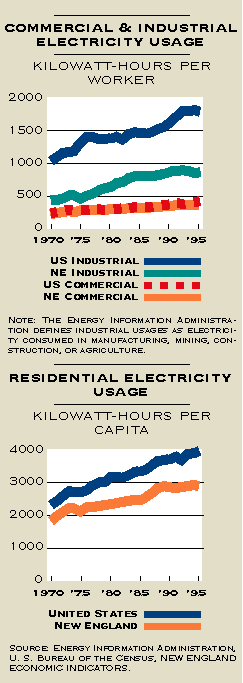Observations 
Less than a Jolt?
 Most New England States have recently opened electric power generation to competition, and some have mandated a fall in the generation price of electricity. (Transmission and distribution will still be regulated monopolies). Many observers expect that these lower prices will spur economic expansion and improve the region's competitive position relative to other parts of the country.
Most New England States have recently opened electric power generation to competition, and some have mandated a fall in the generation price of electricity. (Transmission and distribution will still be regulated monopolies). Many observers expect that these lower prices will spur economic expansion and improve the region's competitive position relative to other parts of the country.
The initial impact may be limited, however. Electricity usage per worker is significantly lower in New England than it is nationwide, points out Boston Fed economist Robert Triest. The difference stems from New England's industrial mix. New England manufacturing is dominated by electronic equipment, instruments, and other sectors that do not use a great deal of electricity. Power-intensive industries such as steel mills and chemical refineries are not prominent here. (In the commercial sector, which includes service and retail, New England electricity usage is roughly the same as the national average.) Residential electricity usage, moreover, is also significantly lower in New England. Oil and gas, not electricity, are the prime energy sources in home heating systems throughout the region. Fast growing Sunbelt states, by contrast, use more electric heating. They also use air conditioning more intensively and for a much longer season.
Falling electricity prices are clearly a positive economic factor - the reverse of the oil shocks of the 1970s, though milder in effect. But for any given drop in electricity rates, regions that are more electricity-dependent will reap greater benefits than New England.
- MARIE WILLARD
Charitable Deductions
Are New Englanders really skinflints? That was the conclusion of a study by the Chronicle of Philanthropy which was widely publicized early this winter. New England states ranked among the lowest in charitable contributions, with Rhode Island dead last. Utah and various southern states ranked highest.
But the methodology that led to this conclusion is suspect. The study examined itemized tax returns to determine the average deduction for charitable contributions in each state. As Boston Fed economist Robert Tannenwald points out, the incentives for itemizing taxes vary from state to state. Since housing costs (and to a lesser extent, state and local income and property taxes) are relatively lower in the South, residents who itemize there are more likely to be those who made charitable contributions. Charitable givers are more likely to make up a higher percentage of the itemizers than in New England, where high housing costs make it worthwhile for more people to itemize in order to deduct mortgage interest. So the population of itemizers across states is not representative of charitable givers.
New Englanders might be less or more generous than elsewhere, but tax returns can't settle the matter.
- JOHN CAMPBELL
Paying for Time
As families grow more affluent, their time becomes more valuable. Work schedules for two-income households, and the proliferation of leisure activities now available to these families, put a premium on reducing the time spent on chores and errands. So a growing number of businesses in New England now offer services designed to save on errand time. Peapod and Home Runs, for example, operate grocery delivery services. These firms choose items from the store or their own warehouse and deliver to your doorstep. At both firms, deliveries are free on orders of more than $60.
A company called Streamline goes even further, by offering to eliminate several routine chores. For $30 per month, Streamline does the weekly grocery shopping, delivers prepared meals, rental videos, and makes runs for dry cleaning, bottle returns, processed film, and postage stamps. Vice-president Frank Britt calls the service "a total shopping solution for the busy suburban family."
One indication of the value of these services is the relatively high compensation some firms pay drivers, with wages comparable to drivers of the major package express corporations. Besides the physical demands of carrying heavy loads into garages and up stairs, drivers must have good interpersonal skills. As the face of their company, good drivers can strengthen customer loyalty in the face of an increasingly competitive market.
- DELIA SAWHNEY



